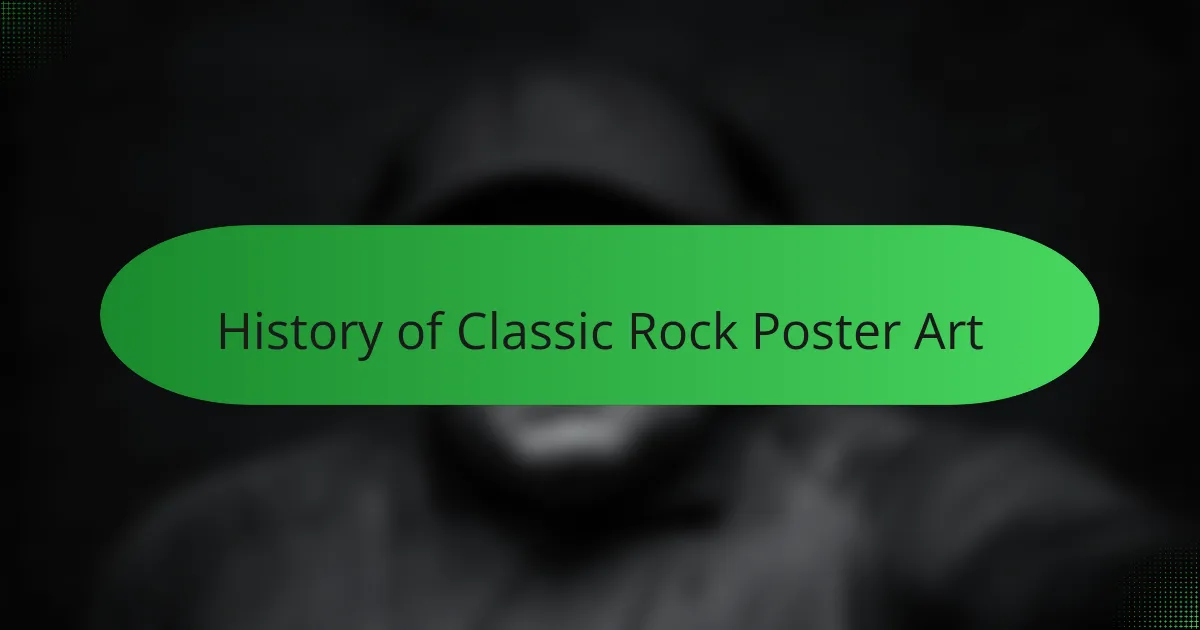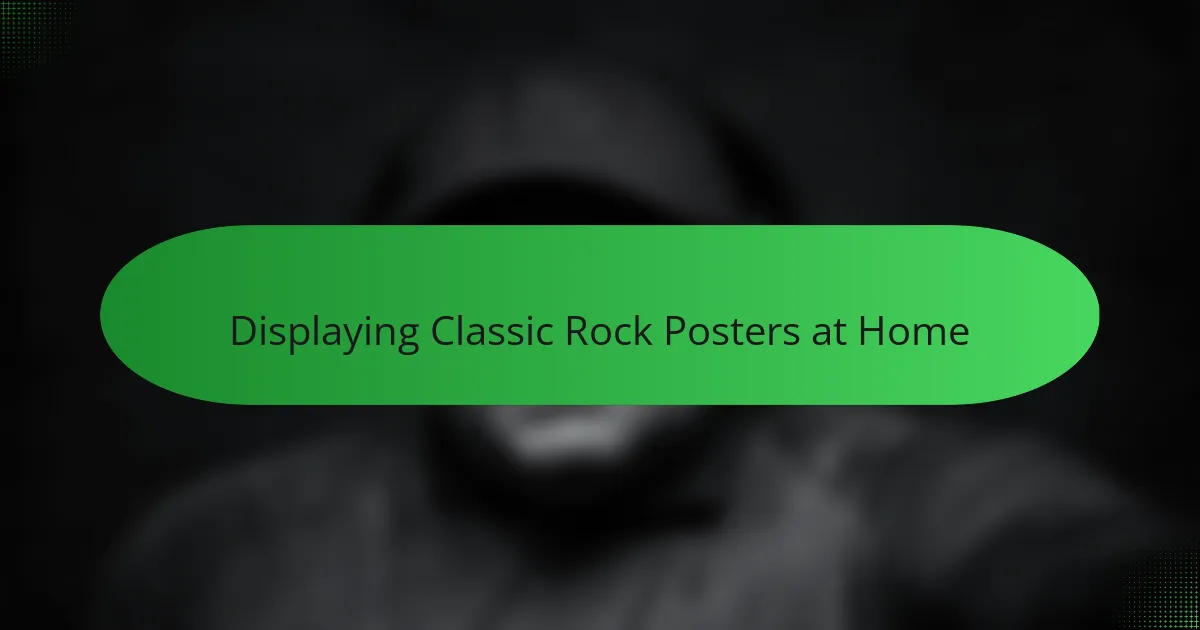Key takeaways
- Classic rock posters are not just advertisements; they encapsulate the passion and spirit of an era, reflecting the energy of the music they represent.
- The evolution of poster art mirrors cultural shifts in the 1960s and 70s, showcasing iconic designs from artists like Wes Wilson and Stanley Mouse.
- Choosing posters should be based on personal connection and story rather than just rarity, making the collection more meaningful.
- Preserving posters involves protecting them from sunlight and using acid-free materials for storage and framing to maintain their vibrancy and integrity.

Introduction to Classic Rock Posters
Classic rock posters have always held a special place in my heart. There’s something about the bold colors and iconic imagery that instantly transport me back to the golden era of rock music. Have you ever noticed how these posters don’t just advertise concerts but tell stories about the energy and spirit of the time?
I remember hanging a Led Zeppelin poster in my room as a teenager, and it wasn’t just decoration—it felt like having a piece of rock history right above my bed. These posters are more than just artwork; they capture the passion, rebellion, and raw emotion that classic rock bands poured into their music. Isn’t it amazing how a simple print can evoke so many memories and feelings?
Looking closely at these posters, it’s clear they were designed to grab attention and inspire excitement. The fonts, the vivid contrasts, and the imagery all work together to create an atmosphere even before the music starts. It makes me wonder how much thought and creativity went into each one, reflecting the essence of the bands they represent.

History of Classic Rock Poster Art
When I first started diving into the history of classic rock poster art, I was amazed to learn how deeply it’s tied to the cultural shifts of the 1960s and 70s. These posters weren’t just ads—they were vibrant expressions of rebellion, freedom, and a new way of seeing the world. I find it fascinating how artists like Wes Wilson and Stanley Mouse brought psychedelic styles to life, making each poster a visual extension of the music’s energy.
The evolution of poster art also reflects the changing venues and audiences of rock music. Early on, hand-painted and screen-printed posters were a big deal, crafted with such care that each one felt like a collectible treasure. I remember coming across a vintage poster from the Fillmore, and it struck me how much personality the artists poured into those designs—they weren’t just functional; they were iconic pieces of art that told stories about the scene.
Isn’t it incredible how these posters still captivate us today, decades later? They capture a moment in time when music, art, and culture collided in a way that felt revolutionary. To me, owning a classic rock poster is like holding a ticket to that era’s spirit, a reminder that music isn’t just heard—it’s felt and seen in colors and shapes that continue to inspire.

Common Designs and Themes
When I look at classic rock posters, I always notice the bold, swirling colors that seem to pulse with the music itself. These psychedelic designs aren’t just visually striking; they echo the mind-expanding vibes of the era. Have you ever been drawn into a poster’s wild patterns and felt like you were stepping right into the concert’s energy?
Another common theme I appreciate is the use of iconic band imagery—whether it’s a striking portrait of the lead singer or symbolic elements like skulls, guitars, or vintage cars. To me, these visuals don’t just identify the band; they capture the attitude and personality that defined their sound. It’s like each poster tells a mini-biography of the band’s spirit in a single frame.
What really fascinates me is the clever blend of typography with the art. The fonts often look hand-drawn, vibrating with an almost rebellious texture, perfectly matching the music’s raw power. It makes me wonder how much these artists understood about branding before it was even a buzzword. Don’t you think that bold, expressive lettering adds a voice to the poster itself?

How to Choose Posters for Your Collection
Choosing posters for your collection can feel overwhelming at first, but I’ve found that focusing on the bands and concerts that resonate with you personally makes the process much more meaningful. Have you ever picked up a poster just because it spoke to a memory or feeling? That connection often matters more than rarity or price.
I also pay close attention to the artwork itself—sometimes a poster’s design can capture the spirit of a band better than the music alone. For example, I once chose a poster not just because it was from my favorite gig but because the colors and imagery perfectly expressed the vibe I remember from that night. Doesn’t it make collecting more fun when the art tells a story you love?
Another tip I’ve picked up over time is to consider the condition and authenticity of a poster. Owning a vintage piece with some wear can feel like a badge of honor, but I prefer finding ones that still pop with vibrant colors and clear print. After all, isn’t the joy in displaying your collection and sharing those stories with friends?

Displaying Classic Rock Posters at Home
When it comes to displaying classic rock posters at home, I’ve always believed that placement really sets the mood. For me, hanging a bold, psychedelic print in the living room instantly sparks conversations and brings a lively, nostalgic energy to the space. Have you noticed how the right spot can make a poster feel alive, almost like it’s still pulsing with the music?
I tend to mix framed posters with some casually pinned ones, creating a vibe that’s both curated and effortlessly cool. It reminds me of those concert halls where every inch was covered in art, music, and memories—it feels authentic rather than stuffy. Plus, switching up the displays occasionally keeps my room feeling fresh and connected to different rock eras I love.
One thing I always caution against is overcrowding the walls. It’s tempting to showcase your entire collection at once, but I find that giving each poster some breathing room lets its unique story shine. Have you ever stared at a wall full of posters and felt overwhelmed? A simple gallery arrangement or a single standout piece can speak volumes without shouting.

Personal Favorites and Stories
One of my all-time favorite posters is the Rolling Stones’ 1972 tour print. I picked it up at a flea market almost by chance, and holding it in my hands felt like touching a piece of rock legend. Have you ever had that moment where a poster just clicks with you, making the music and memories feel even more alive?
There’s also a special story behind my Pink Floyd “Dark Side of the Moon” poster. It was a gift from a close friend who knew how much that album shaped my teenage years. Every time I look at it, I’m reminded not just of the music but of that friendship and those endless nights spent discussing lyrics and soundscapes. Isn’t it amazing how these posters become markers of personal history?
Sometimes, the posters I cherish most aren’t the rarest or flashiest but the ones that tell a quiet story. Like the one from a small, local show I attended with my family—it’s simple but packed with memories of laughter and first live music experiences. Doesn’t it make collecting feel more like preserving moments than just accumulating art?

Tips for Maintaining and Preserving Posters
One thing I’ve learned about keeping classic rock posters looking great is to avoid direct sunlight. I remember once hanging a poster right by my window, and over time, the colors started fading—I felt like I was losing a bit of that rock magic. Have you ever noticed how sunlight slowly bleaches the vibrancy out of those bold hues? Keeping posters in shaded or dimly lit spots really helps preserve their intense colors and energy.
Another tip I swear by is using acid-free sleeves or backing boards when storing posters you’re not displaying. Early on, I didn’t pay much attention to this and ended up with some creases and yellowing around the edges of a cherished poster. It’s frustrating because these details can dull the whole piece. Using archival materials is like giving your posters a protective hug, preventing damage from moisture or dust that might sneak in over time.
Framing is another game changer in poster preservation, but it’s got to be done thoughtfully. I used to toss posters into any frame I could find, but soon realized that acid-free mats and UV-protective glass make a huge difference in keeping the print safe. Doesn’t it feel better knowing your favorite piece is shielded while still shining as a focal point? Plus, a good frame turns a poster into a centerpiece that celebrates the music and memories behind it.